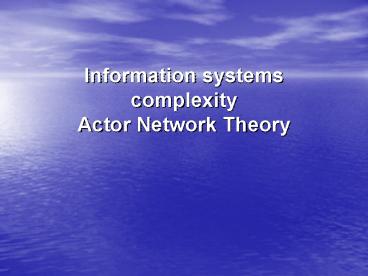Information systems complexity Actor Network Theory - PowerPoint PPT Presentation
1 / 17
Title:
Information systems complexity Actor Network Theory
Description:
National/global networks: Telemedicine, EDI, e-business infrastructures, web ... Integrated systems: ERP, EPR, integrated portfolios, ... – PowerPoint PPT presentation
Number of Views:51
Avg rating:3.0/5.0
Title: Information systems complexity Actor Network Theory
1
Information systems complexityActor Network
Theory
2
The challenges (or the crisis )
- National/global networks Telemedicine, EDI,
e-business infrastructures, web-services, the
Internet, . - Integrated systems ERP, EPR, integrated
portfolios, - Not systems open, indefinite, generic
technologies, use not pre-defined - Discretionary, not mandated use (from users to
customers) - Developing over looooong time
- Informating, enabling new ways of working not
automating - Open (indefinite) networks
- Dramatically increased COMPLEXITY
3
Basic concepts old and new
- System
- Tool
- Requirements specification
- Planning and control
- Modelling
- Iplementation
- Network
- Infrastructure
- Bootstrapping an installed base
- Flexible standards
- Lock-in
- Gateway
- Boomerang effects
4
Complexity
- Mathemathical theories irrelevant!
- Unpredicable (or uncontrollable) interactions,
unpredicatable (or uncontrollable) outcomes - Emergence, history matters
- Autonomous Technology, Risk Society, Normal
Accidents Theory - High Reliability Theory
- Networks
- Heterogeneous networks Actor Network Theory
- Interactions (propagation of side-effects)
Network Economics and Reflexive Modernization
5
Managing Complexity
- Reducing Complexity
- Standardization
- Abstraction, better theories (models?)
- Avoiding complexity
- Managing Complexity
- Reducing, avoiding it
- Better tools
- High Reliability Theory
- Cultivating infrastructures
6
Actor Network Theory
- Understanding heterogeneity interaction between
the social, technical, institutional, - Network of actants
- Origin Social studies of science
- The interaction between social, political,
technological, institutional elements in
construction of scientific facts and theories
(Kuhn) - The third way Between determinism and
constructivism
7
Actor Network Theory 2
- Theory/fact and technology heterogeneous network
- Science and and technological development
- Transforming/building networks
- Actors (heterogeneous) networks
8
Actors
- Always heterogeneous network
- No assumptions about differences between human
and technology - There ARE differences constructed - not given
- Inscriptions of rules and programs-of-action,
delegations of roles and competences, .. - Humans are different
- Technologies are different
- Ideal for studying interaction between humans,
organizations and technology (I.e. the role of
the technology. Compare with Orlikowskis
technological artefact/technology-in-use
distinction)
9
Concepts
- Actants
- Associations/networks/collectives (of hunas and
non-humans) - Translation, composition, enrollment
- Interference
- Inscription, delegation
- Program-of-action
- Black-boxing
- Irreversibility
10
Assumptions
- Everything theories, facts, technologies,
humans are networks/collectives - Network building is a political process
- All actors have interests
- Building alliances
- Power strength size of the network
- The process is embedded in the product
11
Example Lab reports
- Lab reports - Furst
- Solution sequence of translations (of interests
and existing solutions and technologies) - Interests and translations
- More customers
- Better service
- Electronic transmission
- Specific design
12
Lab. orders - continued
- Integration with medical record system
- Giving away modems for free
- Integration with local practices
- For each translation the network (collective)
grows, alignment is maintained
13
Order
- Interests lab improved results -gt cost
containment --gt cut manual registration work
doctors ? patients security, vendors,
authorities, standardization bodies, standards,
????
14
Order continued...
- EDIFACT solution failed to enroll doctors
- Failed to align standardized solution and
doctors interests - First Post ordering
- Appears to be impossible to align with settled
standards
15
Prescriptions
- Social security cost containment more strict
control - Pharmacy Cutting manual registration work,
improved logistics - Patients Less waiting (reiterated prescriptions
?) - Physicians Quality control
- Failed to make a solution that anybody would pay
for - Failed in translateing the interests into an
alignet network
16
More on Prescriptions
- Failed standardizationComplex socio-technical
networks (failed to understand the complex
network of relations between the social and the
technical) - Focused isolated on standardization
- Didnt address the need for translating
technology into use - Blind for interests
17
Design Making inscriptions
- of programs-of-action
- which one?
- How?
- Who?
- How strong is the inscription?
- Can users change it?
- Flexibility!!































